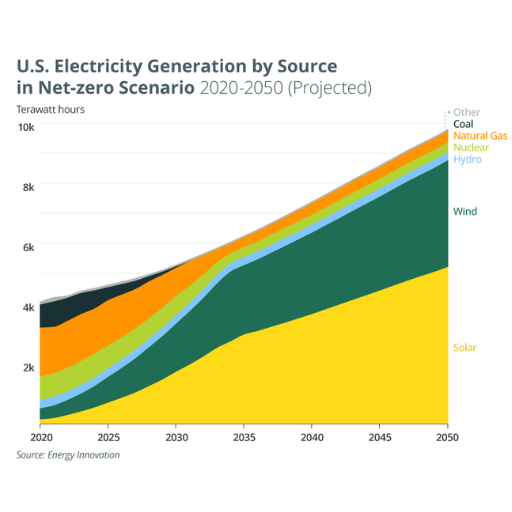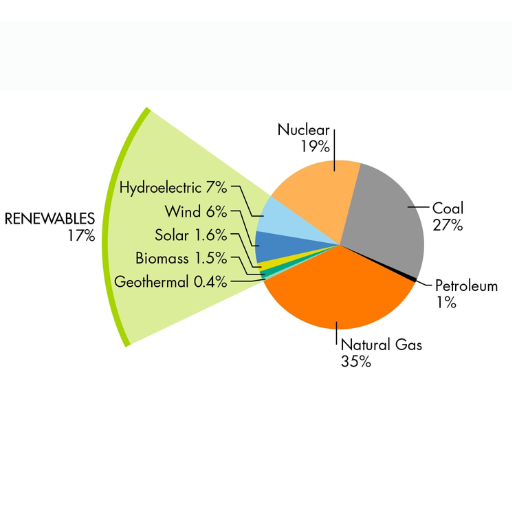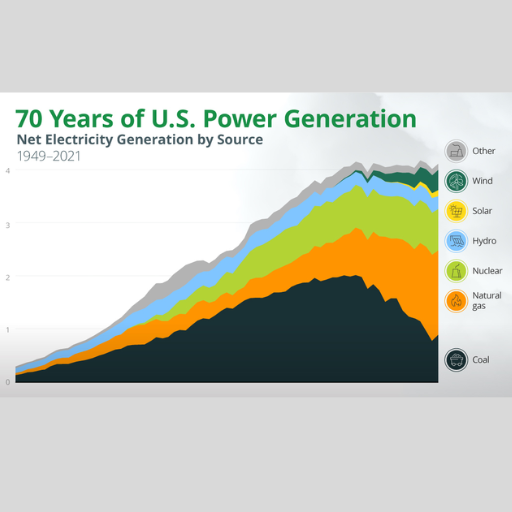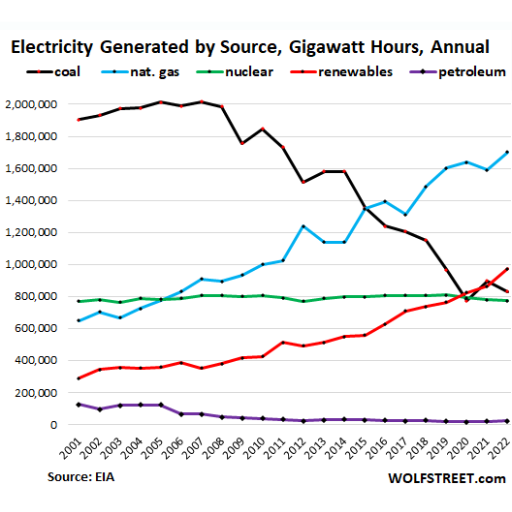With almost every high form of life, electricity power is granted to a house or business. But have you ever stopped to think where does all the energy come from? Depending on the region, the United States has a varied combination of energy sources to generate electricity, as each plays a vital role in meeting the nation’s energy demand. In contrast, renewable energy encompasses wind and solar, whereas fossil fuel-based energy refers to traditional sources such as gas and coal. Electric power generation is a changing landscape. This blog will delve deeply into the sources of electric power in the United States, including their production levels, sustainability, and the trends in these energy sources that may be the focus of attention in the future. This article serves as a helpful guide for anyone interested in green energy developments and seeking more insight into the numbers behind the American grid.
Overview of Electricity Generation in the U.S.

In the United States, electricity generation is a very diverse process. The primary sources of electricity are natural gas, coal, nuclear energy, and renewable sources such as wind, solar, and hydroelectric power. Being the most significant source, natural gas is a reliable energy source due to its efficiency and widespread availability. Renewables are proliferating, with wind and solar leading the way as the country transitions toward cleaner energy solutions. Coal’s use has declined considerably over the years, reflecting a shift toward more sustainable practices. Nuclear power, on the other hand, provides a stable, zero-emission source of electricity, and hydroelectric power remains one of the oldest renewable energy sources. Together, these energy generation options constitute a balanced portfolio that produces electricity, taking into consideration environmental priorities.
Definition and Importance of Electricity Generation
The generation of electrical energy is the production of electrical power from some energy source. It is necessary for the survival of modern society, the promotion of advancement, and the materialization of economic growth.
Current State of Electricity Generation in the U.S.
The United States had an incredibly varied blend of energy sources for electric power generation, ensuring a balanced and resilient grid infrastructure. According to recent data, nearly 60% of the electricity generated in this country comes from fossil fuels, including natural gas, coal, and petroleum. Natural gas, thus, is the primary source for nearly 39% of electricity production during the year 2023. Renewable energy accounts for another quarter of the power mix, comprising wind, solar, and hydropower, reflecting the country’s commitment to reducing carbon emissions. Wind energy includes the largest share of renewables, followed by solar and then hydroelectric. Nuclear energy continues to play a significant role, contributing approximately 18% of the country’s electricity with zero direct carbon emissions.
Purchasing investments in renewable energy projects, coupled with the retirement of coal-fired power plants, hastens a shift toward cleaner energy infrastructure in the U.S. Due to the growth of new technologies and federal policies supporting clean industries with tax incentives, solar and wind generation achieved record growth in the past few years, providing an advantage to the adoption of renewable energy. Such developments align with the country’s goal of reaching net-zero greenhouse gas emissions by 2050.
Key Statistics on U.S. Electricity Production
Electricity Generation in General
The United States generated approximately 4,243 billion kilowatt-hours (kWh) of electricity in 2022. Of this generation capacity, approximately 61% came from fossil fuels (coal, natural gas, and petroleum), 21% from renewable sources, and 18% from nuclear sources.
Renewable Energy Growth
According to 2022 electricity generation data, renewable sources, which include wind, solar, hydro, and biomass, accounted for a significant portion. Wind power generated 10.2% of the U.S.’s electricity, while solar energy contributed 4.8%, indicating constant growth bolstered by federal incentives and declining costs.
Decline of Coal Power
The share that coal has in electricity generation has continued to decline, and in 2022, it accounted for barely 20% of the total electricity generated, in contrast to over 50% in 2000. The share has decreased due to increased competitiveness from natural gas and renewables, as well as stricter environmental regulations.
Natural-Gas-Led Domination
It has been natural gas that has generated electricity throughout the U.S. as of late, accounting for approximately 39% of the total generated in 2022, and still growing due to its good availability and relatively low price.
Energy Transition Goals
The U.S. has an energy transition agenda that plans for 100% carbon pollution-free electricity by 2035. Policies such as the Inflation Reduction Act of 2022 and investments in grid modernization are fast-tracking the retirement of old energy systems in favor of cleaner energy.
Energy Storage Expansion
Investment in battery storage has surged in tandem with the increasing adoption of renewable energy. By the end of 2022, the U.S. had deployed or was in development over 30 gigawatts of energy storage capacity to help stabilize the grid as intermittent sources like solar PV and wind energy grow.
These statistics examine the evolving energy landscape in the country, driven by the dual goals of environmental sustainability and reliability.
Major Energy Sources for Electricity Generation

Natural gas, coal, nuclear energy, renewable energy, and petroleum constitute the primary sources for electricity generation in the United States. Being the major contributor, natural gas supplies much of the country’s electricity as it is considered reliable and abundant. With renewables growing in importance at such a rapid rate, there appear to be mounting environmental concerns and government incentives. Meanwhile, coal and nuclear continue to make their own contributions, but their contribution levels have indeed declined over recent years. Petroleum is smaller nowadays and is mainly restricted to applications where other alternatives may not be suitable.
Fossil Fuels: Natural Gas, Coal, and Oil
|
Parameter |
Natural Gas |
Coal |
Oil |
|---|---|---|---|
|
Composition |
Mainly methane (CH4) |
Carbon and hydrocarbons |
Hydrocarbons (varied chains) |
|
Formation |
Organic matter under heat and pressure over millions of years |
Plant material compressed over millions of years |
Organic matter under heat and pressure |
|
Primary Use |
Heating, electricity, industrial processes |
Electricity generation, steel production |
Transportation, heating, industrial processes |
|
Environmental Impact |
Lower CO2 emissions than coal and oil |
High CO2 and pollutant emissions |
High CO2 emissions, oil spills |
|
Efficiency |
92% energy efficiency in direct use |
Lower efficiency compared to natural gas |
Varies by application |
|
Global Reserves |
Estimated to last over 100 years |
Estimated to last 300 years |
Limited reserves, declining availability |
|
Economic Role |
Supports millions of jobs globally |
Key in industrial and energy sectors |
Major driver of global economy |
|
Extraction Methods |
Fracking, drilling |
Surface and underground mining |
Drilling, offshore platforms |
|
Key Producers |
USA, Russia, Qatar |
China, USA, India |
Saudi Arabia, USA, Russia |
|
Challenges |
Methane leaks, dependency on pipelines |
Environmental degradation, high emissions |
Oil spills, geopolitical tensions |
Renewable Energy Sources: Wind, Solar, and Hydropower
| Parameter | Wind Energy | Solar Energy | Hydropower |
|---|---|---|---|
|
Energy Source |
Kinetic energy from wind |
Sunlight (photons) |
Moving water |
|
Primary Use |
Electricity generation |
Electricity and heat generation |
Electricity generation |
|
Environmental Impact |
No emissions, minor wildlife impact |
No emissions, minimal land use |
No emissions, supports water management |
|
Efficiency |
40-50% capacity factor |
15-20% panel efficiency |
High efficiency, immediate power generation |
|
Global Contribution |
10% of U.S. electricity |
3% of global electricity |
27% of U.S. renewable electricity |
|
Economic Role |
Creates 300,000+ U.S. jobs |
250,000+ U.S. jobs, rural economic benefits |
66,500+ U.S. jobs, boosts local economies |
|
Installation Cost |
Declining, competitive with fossil fuels |
Dropped 86% since 2009 |
High upfront, low long-term costs |
|
Lifespan |
20-30 years |
25+ years |
Long lifespan, durable infrastructure |
|
Challenges |
Noise, visual impact, location dependency |
Land use, material recycling |
High initial cost, site-specific |
|
Key Producers |
USA, China, Germany |
China, USA, India |
USA, China, Brazil |
Nuclear Power: Role and Contribution to the Electricity Mix
Nuclear energy stands among the significant sources of electricity generation, being both a source of controversy and a measure of reliability, with low carbon emissions. It is mainly considered valuable in situations involving electrical power with a constant baseload, contrasting with intermittent renewables like wind and solar. There are five elaborated points that describe the role and contribution of nuclear power:
- Global Electricity Production
Nuclear power contributes approximately 10% to global electricity generation. In countries such as France, nuclear may be said to form nearly 70% of their electricity mix.
- Low Carbon Footprint
Nuclear energy has the least environmental issues concerning greenhouse gas emissions. From a lifecycle view, emissions by nuclear power plants are comparable to those of renewables. Thus, it is a very crucial player in the fight against climate change.
- Energy Security
Nuclear power ensures energy security through a continuous, uninterrupted supply of energy. It reduces the use of incoming fossil fuels, thereby increasing a country’s energy independence.
- High Energy Density
The energy density of nuclear fuel is vastly greater than that of fossil fuels. One kilogram of uranium can generate approximately 24,000 megawatt-hours of electricity, surpassing the energy output of coal and natural gas.
- Technological Advancement
Due to technological advancements, SMRs and next-generation nuclear reactors are expected to provide atomic power with increased safety, efficiency, and affordability in the future. These measures will help address concerns related to safety and waste disposal, thereby fostering global acceptance.
Electricity Generation Trends and Changes

Electricity generation is shifting toward cleaner and renewable energy sources due to environmental concerns and technological advancements. Solar and wind power have experienced rapidly growing markets due to decreasing costs and government incentives. Hydropower is a reliable renewable source, whereas natural gas remains the so-called bridge fuel because it is one of the cleaner fossil fuels compared to coal and thus has fewer emissions. Nuclear power, on the other hand, is gaining attention once more as a zero-emission energy source, particularly with advancements in small modular reactors. These trends highlight the global effort to reduce carbon emissions and transition toward sustainable energy systems.
Shifts in the Share of Electricity Generation by Source
The last decade has witnessed significant transformations in international electricity generation, reflecting a paradigm shift toward sustainability. According to the International Energy Agency (IEA), renewable sources provided slightly less than 30% of the world’s electricity generation as of 2022, with wind and solar capacities being the fastest-growing elements. Solar energy grew 22% in 2022, ranking it among the fastest-growing sources of energy worldwide.
Hydropower power remains the most significant single type of renewable energy, thus contributing roughly 16% to global electricity generation. If anything, the share for hydro has remained relatively unchanged, in marked opposition to the exponential increases in wind and solar. Even today, wind and solar together contribute approximately 12% of the world’s power mix, compared to just 1% two decades ago.
Coal, on the other hand, is diminishing as the dominant source for electricity generation. It still accounted for nearly 35% of the world’s generation, with that share dipping down from over 40% a decade ago. This is due to the halt in coal plant construction in many nations and the shift towards cleaner alternatives for power. Oil generation, on the other hand, is also in decline and currently accounts for less than 3% of the global mix.
Natural gas, on the contrary, due to its lower emissions compared to coal and its ability to provide both baseload and peak-load power, contributes approximately 23% of the global generation. While nuclear has contributed approximately 10% of the world’s total electricity generation, several countries are exploring advanced nuclear technologies, including small modular reactors, to achieve zero-carbon goals.
The shifting shares tell a tale of increasing emphasis being placed on curbing greenhouse gas emissions and promoting energy security. The level of immediacy in the realization of renewable energy suggests that a clear momentum has been generated toward meeting international climate targets, such as those outlined in the Paris Agreement.
Impact of Policy Changes on Energy Production
Policy changes play a crucial role in shaping the landscape for energy production, influencing the adoption of technologies, investment flows, and emissions reduction. All over the world, governments implement various policies to achieve the limited timeframe of transitioning towards cleaner, sustainable energy sources. In consideration of that, here are five uses of policy impacts on energy production:
- Renewable Energy Subsidies
Almost all governments offer financial incentives (e.g., tax credits and grants) to promote the development of renewable energy sources, including solar, wind, and hydroelectric technologies. For example, solar energy was hugely boosted in the United States through tax credits under the Investment Tax Credit (ITC) initiative.
- Carbon Pricing Measures
A carbon pricing policy, such as a carbon tax or cap-and-trade, should price the emissions of greenhouse gases while encouraging industries to switch to clean energy alternatives away from fossil fuels. The European Union’s Emission Trading Scheme is widely discussed as an example of how carbon prices can effectively induce emission reductions.
- Renewable Portfolio Standards (RPS) Mandates
RPS laws in many jurisdictions require utilities to obtain a portion of their energy supply from renewable sources. A clear example is California, which offers 100 percent clean electricity generation by 2045, which has spurred investments in wind and solar power.
- R&D Floats
Governmentally funded R&D for newer energy technologies, such as battery storage, hydrogen fuel, and carbon capture and storage, serves to enhance energy reliability and efficiency. Federal clean energy R&D funding has risen steadily over the past decade in the U.S.
- Elimination of Fossil Fuel Subsidies
Encouraging producers of energy to switch to alternatives through withdrawing, perhaps temporarily, subsidies granted to coal, oil, and natural gas. Fossil fuel subsidies at the global level have been reduced by over 40 percent in the past few years, according to the IEA, in a bid to achieve more general climate goals.
Policy changes will hence speed up this worldwide transition to a sustainable energy future, permitting countries along the way to attain environmental goals while enabling the innovation of energy production.
Emerging Technologies and Their Influence on the Power Sector
The power sector is undergoing a profound transformation, with emerging technologies redefining how electricity is generated, stored, and utilized. Moreover, renewable energy technologies, smart grids, and energy storage systems bring about disruptive changes.
Renewable Energy Technologies: Over the last decade, innovations in solar and wind technology have significantly reduced costs. According to the International Renewable Energy Agency (IRENA), the global weighted average levelized cost of electricity (LCOE) for utility-scale solar photovoltaic (PV) projects declined by 85% between 2010 and 2021. Similarly, onshore wind power costs decreased by 56%, and the offshore wind sector experienced a 48% price decline. These price cuts have enabled renewable energy to compete with fossil fuel power in several regions, thus encouraging widespread adoption.
Energy Storage Systems: Battery technology has experienced significant advancements, particularly with lithium-ion batteries. The most recent report from BloombergNEF states that lithium-ion battery pack prices fell 89%, from $1,200 per kilowatt-hour (kWh) in 2010 to $132 per kWh in 2021. Such decreases in price become very important for the sake of integrating renewable energy, as energy-storage systems help in dealing with the variability in power supply and demand, thereby reducing dependency on traditional baseload generation sources.
Smart Grids and Digitalization: The development of innovative grid technologies is giving a facelift to traditional electricity distribution networks. Such grids utilize sensors, advanced metering infrastructure, and real-time data analysis to enhance energy efficiency and grid stability. For example, the global smart grid market size was valued at nearly $43.1 billion in 2022 and is expected to grow at a CAGR of 19.1% from 2023 to 2030, according to Grand View Research.
Artificial Intelligence and Automation: Another driver of efficiency in the power sector is AI. Algorithms of AI optimize dispatch, minimize system losses, and enhance predictive maintenance of critical equipment, including turbines and transformers. A report from Deloitte in 2023 shows that AI-enabled platforms within the electricity sector could realize operational savings of $80 billion at a global level by 2040.
In addition to increasing the efficiency of power sector operations, these emerging technologies are also accelerating the global march towards a net-zero emissions future. They are providing the electricity industry with new avenues of innovation through which it can sustainably cater to ever-increasing energy demands.
Challenges Facing the U.S. Electricity Sector

Six crucial challenges confront the U.S. electricity sector that threaten its ability to move forward effectively and in a manner advantageous to duration:
Aging Infrastructure
Much of the energy grid was built decades ago, and it now requires further upgrades to ensure reliability and resilience in response to current demands.
Rising Demand for Electricity
With electrification on the rise in transportation, industry, and homes, the sector must expand its capacity to meet the growing energy requirements.
Integration of Renewable Energy
Expanding renewable energy sources, such as wind and solar, brings with it issues related to grid stability and managing their intermittent nature.
Cybersecurity Threats
Such a digitalized grid, therefore, increases exposure to cyberattacks, which can disrupt critical power supplies and result in widespread outages.
Climate Change Impacts
Such extreme weather events, brought about by climate change, put the energy grid under extra stress, thereby leading to more frequent power disruptions.
Addressing these challenges would require the entire gamut of investment, policy reforms, and innovations in the whole industry.
Environmental Concerns: Emissions and Climate Impact
The energy sector remains one of the significant sources of greenhouse gas emissions today, accounting for approximately 73% of all emissions worldwide, as stated by the International Energy Agency (IEA). The most significant contributor to carbon and pollution output is fossil-fuel-based power generation, which includes coal, oil, and natural gas. Therefore, coal-fired power plants alone contribute to nearly 30% of global carbon dioxide emissions.
The climate change impact of these emissions is significant. The result of this high concentration of greenhouse gases in the atmosphere has been rising temperatures worldwide, extreme weather events, and shifting ecosystems. Some projections suggest that if little to no proactive steps are taken, we could see a rise of more than 3°C in global surface temperature by the end of this century. This scenario poses hazards to the delicate balance of ecosystems, human health, and economic stability.
Restoration of the atmosphere has thus called for a higher intensity in reducing emissions, an effort that warrants reliance on renewable energy technologies, which best serve to equate carbon footprints incurred. Further data suggest that renewables contributed more than 30% to global electricity generation in 2022, marking a significant stride forward on the road. Nevertheless, issues of energy storage, grid reliability, and upfront costs remain substantial obstacles to the transition. They have thus been earmarked as focal points that must be addressed on the path to achieving another crucial target: net-zero emissions by 2050.
Infrastructure and Investment Challenges
In infrastructure and investment, a significant challenge I see is that, on the one hand, there is a need for the rapid deployment of renewable energy projects. On the other hand, existing high upfront costs provide a long-term foundation for such ventures. Resolving the issues requires fostering public-private collaborations, promoting innovation in energy storage, and ensuring fair access to funding for developing regions. Working on these fronts, in my opinion, should go some way toward building a better and more reliable renewable energy infrastructure.
Key Challenges in Transitioning to Renewable Energy
Transitioning to renewable energy is a crucial step in countering climate change and reducing our dependence on fossil fuels. Yet this transition comes with its challenges. The following are five main challenges, backed with data and information, that need to be resolved for the transition to a sustainable energy system:
- High Initial Investment Costs
Renewable energy projects require infrastructure that necessitates significant upfront investments, such as solar panel installations, wind turbine setups, and energy storage systems. Investments in infrastructure for renewable energy worldwide are expected to amount to $131 trillion by 2050, according to the International Renewable Energy Agency (IRENA), posing a significant financial challenge for several developing countries.
- Intermittency and Reliability Issues
Solar and wind energy are weather-dependent to some extent, causing inconsistency in power supply. For instance, solar panels do not generate electricity on cloudy days or at night, while wind turbines require a certain speed of wind. Such intermittency, therefore, undermines the grid’s stability and calls for advanced energy storage mechanisms to fill the gaps.
- Infrastructure Requirements
Conversion to renewable energy necessitates further upgrading of power grids, which are currently an outgrowth of large centralized fossil fuel generation. Modernizing the grid to accept decentralized and variable power generation sources is itself a significant task, with an investment estimated by the U.S. Department of Energy to be $2.1 trillion by 2030.
- Global Inequality in Access to Resources
Many developing countries lack the financial resources, technical expertise, and infrastructure to transition to green energy. According to a World Bank study, more than 770 million people worldwide still lack access to electricity, with the majority residing in sub-Saharan Africa, thereby restricting them from entering a clean energy pathway.
- Supply Chain and Raw Material Constraints
Renewable energy technologies rely on rare earth minerals such as lithium, cobalt, and nickel for batteries and other components. The skyrocketing global demand for these materials is causing supply chain disruptions and rising prices. The price of lithium, for example, increased by over 400% between 2021 and 2022, thereby making energy storage solutions significantly more expensive.
Addressing the challenges effectively would require coordination between governments, industry, and international organizations. Taken as a way to resolve the challenges, the transition towards a renewable energy future can become easier for all.
Future Projections for U.S. Electricity Generation

The electricity generation mix in the U.S is slated to change mechanically as we go into the future decades. Renewables, with wind and solar at the forefront, would typically represent the bulk of growth due to falling prices and increasing output. The EIA forecasts that around 40% or more of electricity generation will be attributed to renewables by 2050. It will undoubtedly remain in the mix as a natural gas energy source, but the absolute share will reduce with the decline in coal usage. The growth in battery storage technology will further support the green transition, allowing for a reliable and flexible grid. Overall, the U.S. is charting a course towards an energy future that is more sustainable and diversified.
Predicted Changes in Energy Mix by 2025
By 2025, the energy mix in the United States is expected to undergo significant changes as the nation continues its transition to a cleaner energy sector. Renewable energy is expected to increase its share and will likely dominate electricity generation, with solar and wind power accounting for the majority. According to the EIA, by 2025, renewables are expected to furnish nearly 33 percent of total electricity generation, compared to 24 percent in 2020. Solar energy, in particular, is expected to grow significantly due to falling installation costs and policy support, accounting for approximately 15 percent of the country’s energy production.
In the meantime, natural gas will continue to be a prominent member of the grid, providing roughly 35 percent of the energy mix, although less than 39 percent in 2020. The coal phase-out shall continue to intensify, declining below 15 percent as more and more aged coal plants are retired and eventually replaced by cleaner alternatives.
Technological development, particularly in battery storage, is expected to be pivotal in ensuring the larger-scale penetration of renewables. Grid-scale energy storage capacity is projected to increase fourfold by 2025, enabling energy storage, along with renewable generation sources, to form a more reliable power grid capable of handling variability in renewable energy generation.
In general, 2025 is likely to witness an energy mix in the United States that still prioritizes sustainability, with key ingredients including technological innovation, government incentives, and a growing awareness that it is time to address carbon emissions.
Long-Term Trends in Energy Consumption and Production
When discussing long-term trends in energy consumption and production, sustainability and decarbonization remain at the core. In the transformation, renewable energy like solar and wind would lead, given better storage technologies. Energy consumption will also be reduced through intelligent energy management systems, leading to even greater energy efficiency. Along with this, conventional fossil fuel use will decline gradually as clean energy becomes more accessible and cheaper. The ongoing transition stands as one of the critical junctures of climate change mitigation and the reshaping of our energy future.
Innovations Shaping the Future of the Electricity Sector
The electricity sector is undergoing a profound transformation due to innovative breakthroughs and the urgent need to mitigate climate change. Solar, wind, and hydroelectric power, being some of these innovations, are prevailing at the forefront. For example, renewable energy is expected to reach 4,500 GW globally by 2030, according to the International Energy Agency (IEA). The picture, solar power continues to break records, with photovoltaic systems dropping in cost by more than 80% over the past decade and thus offering one of the cheapest methods to produce electricity for substantial parts of the world.
Energy storage technologies, such as next-generation lithium-ion batteries and emerging technologies like solid-state batteries, are among the key players in this arsenal. They make it possible to work around the intermittent nature of renewables by storing the energy formed efficiently and putting it into use at the time of need. Global energy storage is expected to experience explosive growth and surpass 1,000 GWh by 2030, according to BloombergNEF, driven by falling battery costs.
Moving to the next level, smart grids and digital energy management systems are re-arranging the paradigms of how electricity is distributed and used. Smart grids utilize IoT devices, AI technology, and real-time data to optimize energy distribution, mitigate grid outages, and enhance efficiency. For example, a report by MarketsandMarkets estimates that the global smart grid market will grow from $43.1 billion in 2021 to $103.4 billion by 2026.
Ultimately, the adoption of electrification in end-use sectors, such as transportation, is yet another catalyst for disruption. Projections suggest that EVs will constitute more than 60% of global passenger car sales by 2030, thus bringing about a need to strengthen charging infrastructure for EVs and solutions for grid integration.
Finally, innovations in green hydrogen production provide an additional versatile and sustainable energy vector. Green hydrogen, supported by a decline in the cost of electrolysis, is expected to meet up to 24% of the world’s energy needs by 2050, according to the International Renewable Energy Agency (IRENA).
The mentioned innovations, supported by policy frameworks, public-private partnerships, and investments, provide accelerated momentum for the electricity sector to become clean, innovative, and sustainable. The evolution will give this side of innovation for resilient consideration and efficiency in tackling the issues of climate change and global energy demand.
References
-
ScienceDirect:
- Article: “Electricity generation from renewables in the United States: Resource potential, current usage, technical status, challenges, strategies, policies, and future directions”
- Link to article
-
National Agricultural Law Center:
- Report: “US renewable electricity generation: Resources and challenges”
- Link to report
-
Taylor & Francis:
- Chapter: “Renewable electricity generation in the United States”
- Link to chapter
Frequently Asked Questions (FAQ)
What is the primary energy production for electricity generation in the U.S.?
The primary energy production for electricity generation in the U.S. includes a mix of sources such as natural gas, coal, nuclear energy, and renewables like wind and solar. Natural gas has become the largest source of electricity, followed by coal and nuclear power. The shift towards renewable electricity is significant, aiming to reduce emissions and reliance on fossil fuels.
How does net electricity generation vary by energy source in the U.S.?
Net electricity generation in the U.S. varies significantly by energy source. In recent years, natural gas has become a dominant source of electricity, accounting for a significant share of the nation’s net electricity production. Renewable sources such as wind power and solar energy have been rapidly increasing, while coal power has declined due to environmental regulations and market forces.
What role do power plants play in electricity generation in the United States?
Power plants are crucial for electricity generation in the United States. They convert various energy sources into electric power, providing the backbone of the electricity sector. Different types of power plants, including thermal power plants, nuclear plants, and renewable energy facilities, contribute to the diverse electricity mix that meets the country’s electricity demand.
How is renewable electricity shaping the electricity generation landscape in the U.S.?
Renewable electricity is reshaping the U.S. electricity generation landscape as more states adopt clean energy policies. With increased investment in wind power and solar energy, renewable sources are becoming a significant part of the electricity supply, reducing overall emissions from the power sector and enhancing the sustainability of energy production.
What is the impact of the Energy Information Administration on electricity generation data?
The Energy Information Administration (EIA) plays a vital role in providing data on electricity generation in the U.S. By analyzing trends and statistics, the EIA helps stakeholders understand energy production, consumption patterns, and electricity prices, which are essential for making informed decisions in the energy sector.
How does electricity demand influence net electricity generation in the U.S.?
Electricity demand has a direct influence on net electricity generation in the U.S. Higher demand typically leads to increased electricity production, prompting power plants to operate at higher capacities. The balance between electricity used and generated is crucial for maintaining grid stability and ensuring reliable electricity supply.
What are the emissions associated with different energy sources for electricity generation?
Emissions associated with electricity generation vary depending on the energy source. Coal power plants produce the highest levels of greenhouse gases, while natural gas power plants emit fewer emissions. Renewable electricity sources, such as wind and solar, have minimal emissions, making them key players in the transition to low-carbon electricity generation.
What trends are expected in electricity generation by energy source in 2024?
In 2024, trends suggest an increase in the share of renewable sources in the electricity generation mix. With advancements in technology and government incentives, solar power and wind energy are expected to continue growing, potentially leading to a decreased reliance on fossil fuels and a further decline in coal power generation.







